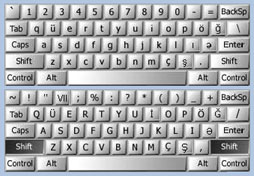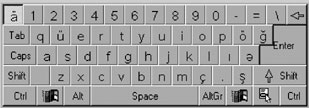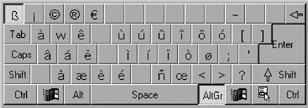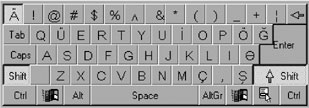|
Speakers of minority languages must help each other. Nobody will do anything for us. We don't represent big money for international companies. They would be happy if all countries used only one language, and if all the former Soviet countries just used Russian. Unfortunately, few people understand the true implications of being able to use one's own native language. Some years ago I started to use the Keyboard Layout Manager program as a hobby. This program enables amateurs to redesign and create new keyboard layouts. Reading Azerbaijan International magazine, I've noticed that the Microsoft Keyboard Layout for Azeri Latin for Unicode has some serious shortcomings. Proposal for Unicode Layout I would like to propose the following keyboard layout for Unicode, which has several advantages in relationship to the standard English keyboard layout. My layout is based on the following principles: (1) All Azeri letters are placed exactly on their identical English counterparts with the additional non-conforming Azeri letters being placed on the peripheral keys on the right side of the keyboard on Rows 2, 3 and 4. An attempt has been made to place highly frequently used letters in the Azeri alphabet on keys that are easy for the fingers to reach ergonomically. (2) All letters and symbols on the standard English keyboard are retained exactly on the same key that they appear, though some symbols must be created on Level 3 or Level 4 instead of 1 and 2. It was necessary to use several levels in order to accommodate all the Azeri letters and still maintain all the standard symbols. Level 1 is normal position. Level 2 refers to the keyboard in Shift position. In other words, Level 1 and Level 2 enable you to type the usual lower case letters and capital letters. To use keys on Level 3: for IBM, press AltGr/Right Alt (or Right Alt + Ctrl on some computers). Level 4 for IBM is accessed by pressing AltGr/Right Alt (or Right Alt + Ctrl on some computers) plus Shift. For MAC, substitute Option for AltGr/Right Alt in the instructions above. Of course, for anyone who has access to a Keyboard Layout Manager program and the time and inclination, it is easy to assign a specific letter to a key, but for people who spend their time primarily typing between Azeri and English, the layout shown below should facilitate speed, reduce time by eliminating common errors and, most importantly, eliminate most of the mental gymnastics that Azerbaijani typists have to go through if they type mostly English and Azeri. Note the additional advantages of my proposed layout over the Microsoft Keyboard Layout. (1) The punctuation mark, "period", which is a high frequency symbol, is retained exactly in the same position as the standard English layout, rather than shifting one space to the right as it appears in Microsoft. The "comma" is above the "period", available on the Level 2 (Shift), not on the usual English standard key to the left of the period. This change was necessary in order to pair the Azeri alphabet letter (Ç,ç). (2) The English letter (W/w) is available on the same key as it appears on the standard English keyboard, but on Level 3 (w) and Level 4 (W). The letter (W) is not included on Microsoft's Unicode layout for Azeri, but including it allows flexibility when Azeri text must include words with "w", especially names, such as Swiss, Brown, World and Airways. With Microsoft, it is necessary to revert to a non-Azeri font. (3) All currency is made available on the same key on different levels See "Number 4" on Level 2 (Dollar), Level 3 (Euro), and Level 4 (British pound). "Dotted a" (Ä/ä), or "umlaut a" as it is often referred to, which was replaced in 1992 by "schwa" (W) after only a few months' use, is available in my Unicode layout as it may still be needed on occasion (Ä/ä is also used to type German and Swedish). Placement is left of Number 1. I hope this layout proves to be useful for some readers, especially those who spend most of their time working between English and Azeri. Questions or comments are welcome. Editor: Note that Unicode will work only on IBM computers with Windows 2000 and XP systems. Prior to Windows 2000, the Unicode technology was not fully implemented and Windows 98 does not display the schwa. For MAC, System X must be installed. For IBM computer users, this proposed Keyboard Layout can be downloaded free at AZERI.org - a Website devoted to Azerbaijani language and literature by Azerbaijan International magazine. Ismael Funes-Aguilera Barcelona, Spain isamukim@yahoo.es
|





